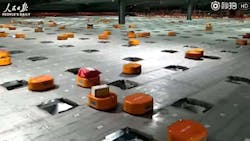Robots Help Warehouse in China Cut Labor Costs
Shentong Express, a delivery company in Hangzhou, Zhejiang province is using robots that can sort 200,000 packages per day. And that is translating into higher productivity.
A spokesman for the company told the South China Morning Post that the robots helped the company save half the costs it typically required when using human workers.
The robots, which are manufactured by Hikvision are self-charging and very efficient according the company. “We want to start using these across the country, especially in our bigger centers," a Shentong spokesperson told the South China Morning Post, adding that the robots improved efficiency by 30%.
Workers hand the robot a parcel and then the robot delivers it to the correct chute in the warehouse floor.
"Our working process starts with the scanning of a bar code which matches the geographical information. Then it automatically calculates the path to find the corresponding drop," said operational director Gao Peng, as reported by Huffington Post.
China is ahead of other countries when it comes to robot density measured by the number of robots per 10,000 manufacturing workers. For China it was 36 in 2014, compared with 478 in the Republic of Korea, 314 in Japan and the world average of 66, according to the International Federation of Robotics (IFR).
This density will continue to grow as the country’s five-year plan, announced recently, is to triple its annual production of industrial robots to 100,000 each year by 2020.
China plans to spread the use of industrial robots in industries such as car manufacturing, electronics, home appliances, aviation, textiles, chemicals, logistics and food production.
China was the largest market for industrial robots for the second straight year in 2014, with sales rising by 56% year on year to 57,000, a quarter of the total sold globally. But only 17,000 of those robots came from domestic vendors, 78% more than the year before, according to the Ministry of Industry and Information Technology .
The IFR forecast industrial robot sales in China will rise to 150,000 in 2018.
